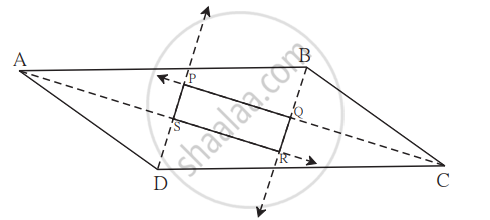Advertisements
Advertisements
Question
Draw a rectangle ABCD such that l(AB) = 6.0 cm and l (BC) = 4.5 cm.
Solution
Steps of Construction:
Step 1: Draw AB = 6 cm.
Step 2: Draw ∠ABX = 90º.
Step 3: With B as centre and radius 4.5 cm, draw an arc cutting the ray BX at C.
Step 4: With C as centre and radius 6 cm, draw an arc.
Step 5: With A as centre and radius 4.5 cm, draw an arc cutting the previous arc at D.
Step 6: Join AD and CD.

Here, ABCD is the required rectangle.
RELATED QUESTIONS
Two adjacent angles of a parallelogram are (3x − 4)° and (3x + 10)°. Find the angles of the parallelogram.
In Fig. 17.29, suppose it is known that DE = DF. Then, is ΔABC isosceles? Why or why not?
Diagonals of a parallelogram ABCD intersect at O. AL and CM are drawn perpendiculars to BD such that L and M lie on BD. Is AL = CM? Why or why not?
Find the length of the diagonal of a rectangle whose sides are 12 cm and 5 cm.
Prove that quadrilateral formed by the intersection of angle bisectors of all angles of a parallelogram is a rectangle.

If diagonal of a rectangle is 26 cm and one side is 24 cm, find the other side.
The interior angle made by the side in a parallelogram is 90° then the parallelogram is a
A quadrilateral whose opposite sides and all the angles are equal is a ______.
Every trapezium is a rectangle.
A line l is parallel to line m and a transversal p intersects them at X, Y respectively. Bisectors of interior angles at X and Y interesct at P and Q. Is PXQY a rectangle? Given reason.
